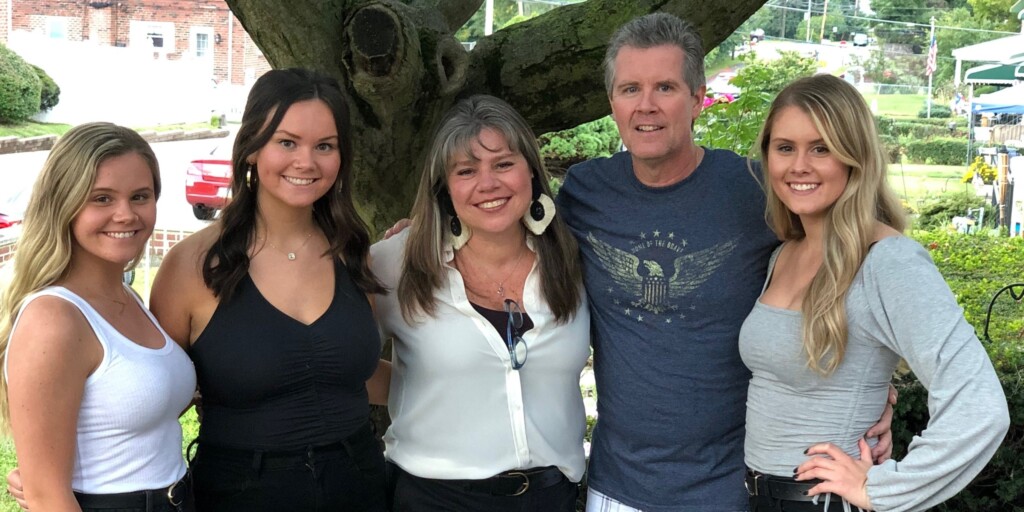
Queer Eye’s “Silver Lining” Sweeneys Stay in the Moment
By Lindsey Baker | Thursday, November 5, 2020
The Sweeneys — John, 58; his wife, Jennifer, 50; and daughters Dana, 24; Rachel, 22; and Ashley, 19 — live in a rowhouse in a small suburb outside of Philadelphia. Their street, John says, is busy — not unlike life inside the rowhouse lately.
During the pandemic, the girls were living, working, and attending school at home. Jennifer has been working from home. The family moved forward with some renovations in the house, following some higher-profile changes made last year — and debuted this year in season five of Netflix’s “Queer Eye,” set entirely in and around Philadelphia.
The family’s — and especially Jennifer’s — go-go-go momentum inspired Dana, Rachel, and Ashley to nominate their mom for some transformation of her own. An involved mom and master of keeping the Sweeney rowhouse running, Jennifer is also caregiver to John, who was diagnosed with amyotrophic lateral sclerosis (ALS) in 2010. When John had to stop working, Jennifer took a full-time job outside of the house on top of the busy schedule she’d always kept. The girls did help around the house, Jennifer says, but still, she would get overwhelmed. And still, she’d keep going.
“I guess I always thought that things had to look a certain way,” Jennifer says, “like, how John looked or the girls looked or how we acted was a reflection of me. So I always tried to make sure everything looked perfect, when it was just pure chaos in my head.”
The “Queer Eye” Fab Five could step in, the Sweeney girls thought, to help Jennifer see how she might re-envision her own routines to care for herself as much, and as well, as she cares for everyone else.
A new outlook
In each “Queer Eye” episode, the five hosts — Karamo Brown, who focuses on culture; Tan France, who focuses on fashion; Jonathan Van Ness, who focuses on grooming; Bobby Berk, who focuses on design; and Antoni Porowski, who focuses on food and wine — evaluate and upgrade an everyday hero’s personal culture, environment, and style.
In June 2019, Jennifer spent a full day with each of the show’s hosts during the filming of her episode. So her own (and the rowhouse’s) transformations would be a surprise, John, Dana, Rachel, and Ashley spent the week at a hotel. Jennifer wasn’t able to communicate with her family during the week, so she kept a journal detailing her time and experiences with the “Queer Eye” crew so she could share the memories with her daughters once they were reunited.
Bobby began work on renovating the Sweeney home’s main floor and patio, and Jennifer spent some time shopping with Tan to replace hand-me-downs she’d been wearing (along with what became an infamous pair of pajama pants printed with the poo emoji). Jonathan cut and styled Jennifer’s hair, and introduced her to some self-pampering skincare and lash extension routines. Antoni, like Jennifer, has a Polish background, and the two shared and made comforting Polish food together. And Karamo spent some time walking with Jennifer, considering the path she and John had been on prior to his diagnosis and the one they’re on now.
“I really bonded with Antoni,” Jennifer says. “Just the heritage and the way we were brought up. But talking with Karamo … I learned so much from him, and I think it’s made me a better caregiver. It was like, ‘Stop looking at the past. You’ve got to enjoy what you have. Just keep going forward.’ It’s scary. It is. But you can’t bring [the past] back. Every day is a new day, and every day is a new memory. We find new traditions. We do new things. We make new memories.”
At the end of Jennifer’s week with the Fab Five, friends and family gathered in the refreshed rowhouse to see her new look — and new outlook.
“If you’re just constantly running and doing things because you have to, you have to, you have to, that’s not good,” she says. “That’s the thing I probably took from each one of them throughout the week.”
Embracing self-care and help
Since the show, Jennifer says she’s kept up the skincare and eyelash routines Jonathan shared with her, and she’s been able to take more time to relax and not worry about what is or isn’t getting done.
“Self-care doesn’t have to be a hobby or something,” she says. “Just sitting outside with John over the weekend. This weekend all we did was just sit around, watching movies, having a drink. It was just so nice to relax. You don’t have to be doing something. Self-care is just something that you’re enjoying.”
The show did something else for John and Jennifer both: It raised awareness of ALS and connected them to other families impacted by the condition. Jennifer says people have reached out through social media to ask questions about care and to offer support, and she’s been able to offer support back to other caregivers.
“That self-care is really, really important,” she says, “because for some people, you need to walk away. Whether it’s going to get your hair done or just being by yourself, taking a walk, or just going into your bedroom, it really is important for your mental wellbeing. Even if it’s a Zoom call to a doctor, you have to take care of yourself or you’re never going to be able to take care of anybody else.”
John says the “Queer Eye” experience helped Jennifer learn to ask for help.
“Before the show,” he says, “she would never do that because she saw it as a sign of weakness. After the show, I think she’s slowly learning — because it’s something inbred in her — but she’s slowly learning that it’s OK to ask for help, that it doesn’t have to all fall on her.”
Jennifer and John advise couples impacted by neuromuscular disease and caregiving have a frank talk from the point of diagnosis about asking for help.
“I can’t take it personally,” John says. “She can’t do it herself 24/7. She’s gonna need help. So, she’s got to realize that she’s got to ask for help, and she’s got to be willing to give up some of that control that she wants to have over the situation and let somebody else step in. And I have to realize I can’t take it personally.”
There are resources available for assistance, Jennifer says, including MDA. The key is “having that game plan. It’s making sure the person with ALS and the caregiver are on the same page, like, ‘I need help. We need help.’ And you’re going to be better off — you, personally, and then you’re going to be better at taking care of somebody.”
Meet the Sweeneys on “Queer Eye,” and learn more about MDA’s and other caregiver resources on our site.
Disclaimer: No content on this site should ever be used as a substitute for direct medical advice from your doctor or other qualified clinician.




